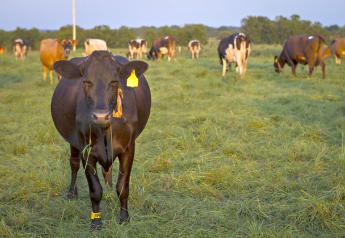Keeping Cows Maternal

A cow that can have a calf all on her own has become so commonplace it’s a trait that’s easy to take for granted.
“One of our biggest success stories is calving ease. Obviously tracking calving dystocia events at birth and weighing those calves have allowed Angus to have a lot of success in the calving ease debate,” says Kelli Retallick-Riley, president of Angus Genetics Inc. (AGI®).
But the “maternal” discussion is far more complex than a healthy live birth, she says, and seedstock producers are using more data and knowledge to create better dams each year.
Retallick-Riley joined breeders Chad Denowh, Gartner-Denowh Angus, and Joe Lowe, Oak Hollow Angus, on The Angus Conversation podcast to discuss what it takes to have cows that work where they live and work further down the line.
“The cows are kind of the employee,” Lowe says. “They have to show up. It’s our job to take care of the cow. It is the cow’s job to take care of the calf.” He and his father raise Angus seedstock near Smiths Grove, Kentucky, where they use both genomics and phenotype to select for good mothers.
“If they can walk, if they can slick off and they can breed — those are the three non-starters if they don’t in our environment,” he says, noting many of his customers deal with fescue pressure.
Both he and Denowh have been early adopters of programs that help turn data into answers, such as the American Angus Association’s Maternal Plus record keeping system.
“We want the cows to look the part first and foremost, but they also have to have the structure, the leg structure, the udder structure, to hold up and stay in these herds for a long amount of time,” says Denowh, who is the sixth generation on his family’s Sidney, Montana, ranch. “Everybody up in this country culls their open cows, and if they don’t stay in the herd, they don’t make you money.”
His family adopted the Angus Herd Improvement Records (AHIR®) program when it came out in the 1970s, so they have more than 50 years of trends to draw on.
“We work a lot with efficiency and raising a good calf in a timely manner,” Denowh says.
Both cattlemen work at having a calf crop that is in demand, no matter the intended marketing.
“There’s a lot of guys that don’t think you can have maternal and carcass together — sure you can, it just takes longer,” Denowh says.
Sometimes that means not using the top carcass bull if it doesn’t meet certain maternal parameters. He’s seen mature cow weights stay moderate while pushing growth and he’s made improvements in calving ease while also improving marbling.
“I don’t think they’re antagonistic at all, any of the traits. I think you just have to find out which traits are most important to you and have a program and stick to it,” Denowh says.
The best cows are those you hardly notice.
“Everyone says the best cow’s the one you don’t know she’s there until she’s six, and you look down and she’s got two daughters in the herd,” Lowe observes.
Retallick-Riley and her team at AGI continues to use the Association’s database — the largest single beef breed database in the world — to find ways to better characterize maternal genetics. That will allow them to create additional selection tools, such as cow fertility or regionally adapted expected progeny differences (EPDs).
Since calving ease EPDs came out in 2005, the breed has steadily added additional traits that aid in cow herd selection, such as docility, heifer pregnancy, hair shed, foot angle and claw set.
“We’ve been spoiled because we have great members who really take care of their cow herd. They cull hard,” Retallick-Riley says. “They really get rid of those problem animals in those problem areas, but we’re here to help them figure out which animals they need to remove from the herd sooner, and that’s really where our genetic tools can come in.”
To listen to the whole conversation on maternal function, subscribe to The Angus Conversation on your favorite podcast platform or visit TheAngusConversation.com.







